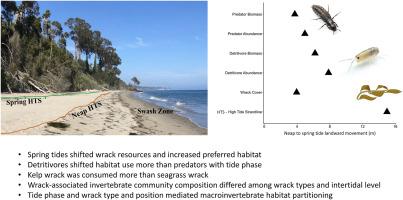Spatial patterns of sandy beach habitat use by mobile invertebrates vary with wrack type and tide phase
IF 2.6
3区 地球科学
Q1 MARINE & FRESHWATER BIOLOGY
引用次数: 0
Abstract
Habitat distributions of many coastal species are expected to shift with climate change and sea level rise, affecting local resource use and biotic interactions. Intertidal zones of sandy beaches support a diversity of highly mobile invertebrates that move frequently to adjust to changing tides as well as habitat availability and condition. Many of these species rely on allochthonous inputs of marine macrophytes, or wrack, for food and shelter. We evaluated the effects of habitat availability and resources on spatial niche partitioning by macroinvertebrate detritivores and predators using field surveys and a field experiment on wrack colonization and consumption. Semi-lunar tide phase greatly affected the amount of suitable habitat (54 % more on spring tide) and the mean position of wrack subsidies on the beach (34 % more landward). Predator and detritivore distributions overlapped, but predators were concentrated higher on the beach. From neap to spring tide, the mean intertidal positions of wrack detritivores expanded more (biomass 49.8 %; abundance 45.4 %) than predator positions. In the experiment, significantly more kelp wrack, Egregia menziesii and Macrocystis pyrifera, was consumed than seagrass wrack, Phyllospadix torreyi, at all intertidal levels. Wrack-associated invertebrate community composition differed among wrack types and intertidal levels. Our findings demonstrate how highly mobile intertidal macroinvertebrates partition beach habitat and food resources, with notable spatial separation between detritivores and predators, and how this behavior can be mediated by tide phase and wrack type and position. Linking spatial dynamics of mobile intertidal animals to future projections of habitat availability and resource supply can inform management of sandy beaches with relevance for their conservation as ecosystems in the face of global change.

流动无脊椎动物利用沙滩生境的空间格局随残骸类型和潮汐期的变化而变化
随着气候变化和海平面上升,许多沿海物种的栖息地分布将发生变化,影响当地资源利用和生物相互作用。沙滩的潮间带支持着各种高度移动的无脊椎动物,它们经常移动以适应不断变化的潮汐以及栖息地的可用性和条件。这些物种中的许多依靠外来的海洋大型植物或残骸作为食物和住所。通过野外调查和残肢定植和消耗实验,评价了生境可得性和资源对大型无脊椎腐食动物和捕食动物空间生态位划分的影响。半月潮期对适宜生境的数量(春潮时增加54%)和海滩上残骸补贴的平均位置(向陆地增加34%)有很大影响。捕食者和腐食动物分布重叠,但捕食者更集中在海滩上。从小潮期到大潮期,腐殖动物的平均潮间带位置(生物量49.8%,丰度45.4%)比掠食性动物的增加幅度更大。在各潮间带水平上,海带残骸门齐鹭(Egregia menziesii)和大囊藻(Macrocystis pyrifera)的食用量均显著高于海草残骸桃叶(Phyllospadix torreyi)。沉船相关无脊椎动物群落组成因沉船类型和潮间带水平而异。我们的研究结果表明,高流动性潮间带大型无脊椎动物是如何分割海滩栖息地和食物资源的,并且在空间上存在明显的食腐动物和捕食者之间的分离,以及这种行为如何受到潮汐阶段和残骸类型和位置的调节。将流动潮间带动物的空间动态与未来栖息地可用性和资源供应的预测联系起来,可以为沙滩的管理提供信息,并与面对全球变化的生态系统保护相关。
本文章由计算机程序翻译,如有差异,请以英文原文为准。
求助全文
约1分钟内获得全文
求助全文
来源期刊
CiteScore
5.60
自引率
7.10%
发文量
374
审稿时长
9 months
期刊介绍:
Estuarine, Coastal and Shelf Science is an international multidisciplinary journal devoted to the analysis of saline water phenomena ranging from the outer edge of the continental shelf to the upper limits of the tidal zone. The journal provides a unique forum, unifying the multidisciplinary approaches to the study of the oceanography of estuaries, coastal zones, and continental shelf seas. It features original research papers, review papers and short communications treating such disciplines as zoology, botany, geology, sedimentology, physical oceanography.

 求助内容:
求助内容: 应助结果提醒方式:
应助结果提醒方式:


